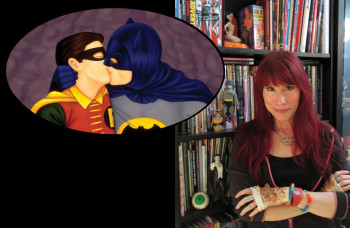Q: Tell me something about your history in the creative arts. Did you have a formal school education or are you self taught?
A: Because I was a bit of an oddball loner kid I had a fair amount of free time on my hands – time I spent in the classic solitary pursuits of reading, writing and drawing. The more I drew, the more I wanted to draw, and after a while it seemed sort of inevitable that I would go to art school so off I went to Parsons, which was great because all of New York was the campus and the city itself was as much a teacher as any of our flesh n’ blood instructors.
Ironically, I had zero interest in the kind of art I’m now obsessed with (I wish I could go back and tell myself to take a totally different course load), so in a way the answer to “Did you go to art school or are you self taught?” is, yes! Because I had to teach myself how to do the kind of work I’m doing now.
Q: We’re interested to hear about your basic inspirations that drive your creative energies.
A: I’m inspired by so many things: jazz from the ’20s; dark chocolate; old horror movies; Baroque painting; the cheesy TV shows of my youth; Flemish primitives; 70s funk and soul; all kinds of critters in the forests and jungles; the Renaissance; fairy tales and fables; the many manifestations, permutations, twists and tangles of love; old school hip hop; and creating stories, interludes and stolen moments with paint.
Q: What were the circumstances that planted that first creative spark in you, and how is that tied to your current inspirations?
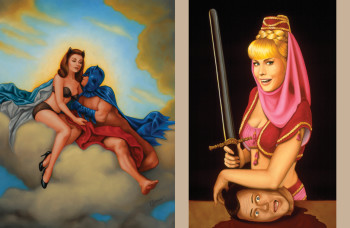 A: When I was a kid my mom used to make paper dolls for me and I was awestruck at this ability to make something out of nothing – to take humble paper and markers and create a whole world. I think that idea really struck some kind of deep, vibrating chord and I’ve been trying to do my own version of that magic ever since – creating things real that only exist in my imagination. That’s always been and still is my mission objective: art as happy alchemy.
A: When I was a kid my mom used to make paper dolls for me and I was awestruck at this ability to make something out of nothing – to take humble paper and markers and create a whole world. I think that idea really struck some kind of deep, vibrating chord and I’ve been trying to do my own version of that magic ever since – creating things real that only exist in my imagination. That’s always been and still is my mission objective: art as happy alchemy.
Q: Was there a particular person in your past that nurtured your creative instincts, like an artist, or a teacher, or mentor of some kind?
A: Every person who ever said “Oh, that’s a great drawing!” or “Are you going to be an artist when you grow up?” helped encourage me to keep going. (Though it’s open for debate whether I will ever actually grow up).
Q: Where does your creative process begin?
A: It’s sort of all over the place, because different images come in different ways. Sometimes I’m inspired by a song, sometimes by the desire to express an emotion or make people laugh, a few ideas have come from dreams, and there are times when it really does feel like I’m waiting for the muse to come and tap me on the shoulder and go “Hey look, over here…” From there, ideas get scribbled and doodled, the doodled become more finished sketches, I gather up any reference I need, and then I can finally bust out the paints. Often I do a lot of research before I even start sketching, reading about the characters I want to paint, or a period in history or the symbolism of different plants and animals, because I like planting things in certain paintings like Easter Eggs — there for the people who can decipher them.
Q: What is a typical day like for you?
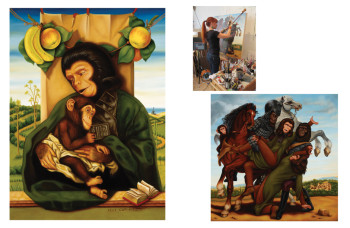 A: I’m not sure there is a typical day — I’d love to say I wake up and march right into the studio but I’m a bit distractible, and though my studio is right behind the house (a commute of all of about two feet), sometimes there are so many things that tug and pull at me. I’m more of a night owl, so maybe the question is “what’s a typical night like for you?” I charge up with some green tea and dark chocolate, throw on a podcast or documentary and paint until I start to question my own judgement. There’s nothing worse than coming in the next morning and realizing that everything you painted the night before isn’t up to snuff.
A: I’m not sure there is a typical day — I’d love to say I wake up and march right into the studio but I’m a bit distractible, and though my studio is right behind the house (a commute of all of about two feet), sometimes there are so many things that tug and pull at me. I’m more of a night owl, so maybe the question is “what’s a typical night like for you?” I charge up with some green tea and dark chocolate, throw on a podcast or documentary and paint until I start to question my own judgement. There’s nothing worse than coming in the next morning and realizing that everything you painted the night before isn’t up to snuff.
Q: Do you have personal partnerships with others connected to your creative sense? Can you speak a bit about that dynamic?
A: Well, the unsung hero of all my work is my husband Marcos. I depend on his honesty and he’s pretty fearless about telling me when something isn’t working in a painting. Everything I do is better for his input, because it’s invaluable to have another pair of eyes giving you real, critical feedback. I don’t always wanna hear it, sometimes I can be downright grumpy about it (especially if it’s late and I just want to be finished), but he’s never wrong. Which is wonderful and irritating.
Q: Say something about the decision making process in your approach to what you do.
A: Often I’ll have several ideas for paintings all rattling around in my head at the same time, and so it becomes a kind of cage match to see who’s going to win. If I let the ideas sock it out for a few days it’s usually pretty obvious which one I’m still thinking about, the one that still seems pleasingly goofy or achingly tender or weirdly disturbing. Then the idea becomes sort of “magnetized,” new bits of ideas will be drawn to it, the scribbles become more coherent, and my fingers get twitchy-itchy to start painting.
Q: Do you ever want to get away from it all? What do you do for release, and to shake out the cobwebs of energy spent?
A: Ugh, when I’ve been pulling a lot of all nighters and starting to feel like a stumbling zombie banging into walls and falling down stairs I truly do have fantasies of just hopping a cab to the airport and buying a one way ticket to someplace tropical. In the depths of deadline despair it seems like it would be really nice to just sit on a beach painting coconuts with googly eyes. In reality, my friends and family keep me from going totally crazy, I bake a lot (sugar therapy!) and am constantly looking for excuses to throw costume parties. (Scottish Banking Holiday? I can work with that!) But my go-to for any mood altering situation is my ukulele. It’s literally impossible to be stressed out or unhappy playing a uke.
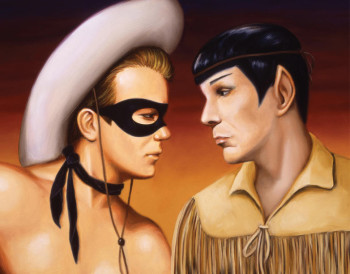 Q: How important, in your art, is the message, as in, imbedding a literal purposeful message into your artistic aesthetics.
Q: How important, in your art, is the message, as in, imbedding a literal purposeful message into your artistic aesthetics.
A: Well *I’ve* always got something I’m trying to communicate but I don’t feel the need to be really bludgeon-y about it – I’d rather use a feather than a hammer. Ideally, the image is imbued with heart and humor and soul but there’s still a little mystery in there so you can be part of the story telling process too. All that said, the most enduring message, the one I return to over and over again, is “love will find a way.” And that’s a very important message to me.
Q: How do you feel living in New York ( …or your city… ) affects your creative energies?
A: When I lived in New York I felt like my energy came *from* the city, like I was plugged into something wonderful and the current flowed directly from the city into my veins. When I moved to San Francisco it was like withdrawal and there was panic because I didn’t feel the same electricity, and I didn’t know where the juice was going to come from. It sounds silly but it actually took me a while to realize that all that came from me, had always been within me – kind of a Dorothy in Oz moment, you know? Realizing that I was wearing the ruby slippers and had the power all along? It was a good moment.
Q: How do you feel the environmental landscape of New York ( …or your city… ) has affected your work?
A: I don’t think I ever painted a single tree or animal until I moved to California! Nature is so much more a part of life here, we’re minutes from the sparkling ocean, huge shaggy redwoods, snow topped mountains, there’s beautiful desert down south a bit, but you’ve still got the vibrancy of the city. Right now there’s this gorgeous necto-plum tree exploding with pink blossoms right outside my studio, and raccoons swagger down the street like a masked biker gang. I’m connected to flora and fauna in a way I never was in NY, and these things have started popping up in my paintings. (Possums won’t just make a nest in your walls, they’re find a way to scramble right into your paintings!)
Q: What do you think of art as activism?
A: I’m all for it, but the last time I painted an overtly political painting (Bush, Cheney, Rove and Condi Rice as the Four Horsemen of the Apocalypse) the gallery it was exhibiting in burned down. I took that as a not-so-subtle sign. I’m very politically active in my non-art life, and more power to people using their art for activism, but I keep the two separate.
Q: Can you say something about your use of storytelling, and its role in your work?
A: A lot of the paintings I riff on in my work existed in a time before TV and radio – they were one of the big story telling mediums of their age. And the people who looked at those images would recognize the tale the artist was telling by the costumes, props, and if all else failed the titled, of the painting. Not as many people now have that level of familiarity with obscure Greek mythology or lesser known Biblical stories, but the themes are pretty timeless (unrequited love, jealousy, acceptance, martyrdom). I often use the characters that are more familiar to my generation — from the TV shows and movies and books and comics that we grew up with – to tell those stories in new ways.
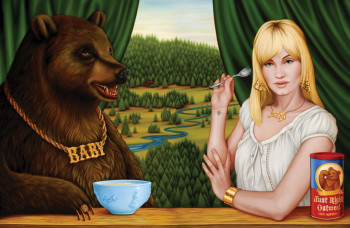 Q: How important is the audience in the personal drive you have to create?
Q: How important is the audience in the personal drive you have to create?
A: Well, I always say I don’t need a huge audience because really each painting is out there on a blind date hoping to meet it’s match and make a love connection. A lot of the time I paint smaller pieces because I want to encourage people to come close and have a personal dialog with the painting, get right up there and have an intimate moment, just the two of you. That’s what I think about most of the time when I’m working — not what effect it might have on a room full of people, but imagining the one person who’s hopefully going to really click with it. I’ve often thought the urge to make these images was at least partly a quest to not feel alone – to find out if other people ever had similar thoughts or feelings.
Q: How does personal intuition play a part in your life’s work?
A: I’m a big fan of intuition, I think we disregard it too often and it’s an ignored sense that’s every bit as legit as our sense of smell. I think the entire artistic process, from the first twinkle of an idea to the final brushstroke, is an ongoing act of intuition, of listening to inner voices, of quieting outside influences and the stupid little naysayer on your left shoulder who can fill you with doubt. Every color you mix, every line you draw, it’s all about giving those inner voices the freedom to guide your hand. Which isn’t to say I approach a blank canvas and just start painting – I’ve done it a few times but that’s a huge struggle for me, definitely not my comfort zone! I like to sketch and sketch and sketch and get everything where I want it, figure as much out as I can, transfer it to the wood panel, and then paint. Usually in the underpainting something will pop up that wasn’t obvious in the sketch, something that needs to be fixed/moved/removed/flipped/whatevered. And you just keep going like that until you stop. (Sometimes I think I would never stop working on a painting if I didn’t have deadlines.)
Q: What would you hope to accomplish in the next few years?
A: I’d like to surprise myself, and I’d like to find more balance and be stressed out less. Sometimes when I overstuff my schedule (because of a seemingly pathological inability to say “no”) it starts to feel like I’ve been running breathlessly in a Flaming Hamster Wheel of Death for a very long, long time. And that’s no bueno. It would be truly wonderful to feel like I was present and giving 100% in all areas of my life. (Short of cloning, I haven’t really come up with a plan to pull that off.)
Q: As a unique voice in the larger artistic community, how does that effect your goals?
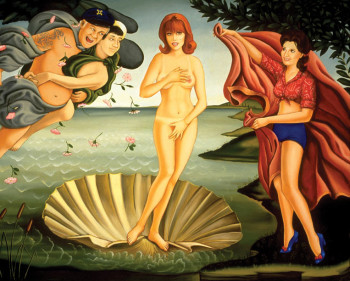 A: Well it’s certainly nice to be thought of a unique voice! I don’t really think about my place, I just do what I do. When I first started exhibiting there were very few women in the “Lowbrow” scene, it was a real boys club, and Lisa Petrucci and Niagara I were always popping up in the same shows. I’m happy to see a much larger number of women artists regularly exhibiting in our little pond now, but that was never a goal, just an expectation — it needed to happen and it did. I’m just going to keep doing what I want to do, following my muse on whatever hair-brained painting adventures she’s cooking up.
A: Well it’s certainly nice to be thought of a unique voice! I don’t really think about my place, I just do what I do. When I first started exhibiting there were very few women in the “Lowbrow” scene, it was a real boys club, and Lisa Petrucci and Niagara I were always popping up in the same shows. I’m happy to see a much larger number of women artists regularly exhibiting in our little pond now, but that was never a goal, just an expectation — it needed to happen and it did. I’m just going to keep doing what I want to do, following my muse on whatever hair-brained painting adventures she’s cooking up.
Q: What is core to your personal mission?
A: I wish I had the ability to make everyone happy, at least some of the time, but barring that I’d like to share an appreciation for good dark chocolate and the redemptive power of amour.
Q: Do you have upcoming projects that you’re inspired with?
A: I’ve been looking at a lot of old black n’ white horror movies again recently, and I do find them soooo inspiring, both visually and thematically. For whatever reason I’ve always been a little obsessed with monsters and the idea that they (often, usually) didn’t ask for their fates, that they’re victims of circumstances. This is a world where I *can* make people happy, play cupid, change lives, alter history.
Q: What is your idea of success?
A: Sleeping well at night.
Q: What makes you happiest?
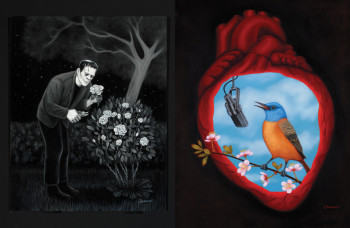 A: Sleeping well at night? I’m actually ludicrously easy to please – sometimes I think I’m happiest when I’m about to tuck into a great meal and laughing with friends. I absolutely love food, the kitchen is definitely my other happy place besides my studio, and sharing good grub and stories with boon companions is pretty high on my list of Happy Moments. Play is important, it helps charge the batteries so you can keep up your fighting spirit and find your flow in the studio.
A: Sleeping well at night? I’m actually ludicrously easy to please – sometimes I think I’m happiest when I’m about to tuck into a great meal and laughing with friends. I absolutely love food, the kitchen is definitely my other happy place besides my studio, and sharing good grub and stories with boon companions is pretty high on my list of Happy Moments. Play is important, it helps charge the batteries so you can keep up your fighting spirit and find your flow in the studio.
Q: What is your moment of perfection?
A: If it were possible to somehow experience all this at the same time: biting into a slice of freshly baked pie, finishing a painting, naked cuddling, unexpectedly perfect weather and the time to enjoy it, and nailing a really difficult chord change on the ukulele.
Q: Where do you go when you need that fire inside you stoked?
A: To the record player. Music is great and records specifically have a warmth, pop and tingle-inducing ability that digital music will never have.
Q: What, to you, is art?
A: Whatever I say is likely to sound dorky but my first impulse without thinking about it was: everything you love. Love to play baseball? That’s your art. Love cooking? Ditto. Art is anywhere you hang your heart.
Q: Wow, it’s 2013! What’s the best part of being who you are right now?
A: Knowing that my Belgian house guest left several pounds of dark chocolate in the pantry.
Q: What do you do in your “other life”?
A: Dance, write, play music, jump around, fall asleep reading.
Q: What is the next answer you have for us that we’ve all been waiting to ask?
A: It’s just a birthmark.



